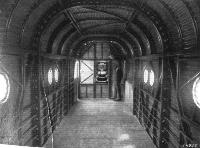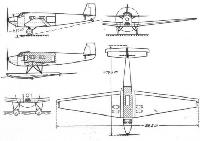Junkers Ju 52/1m и K 54
Первый полет транспортного самолета Ju 52, оснащенного двигателем BMW VIIaU, состоялся в 1930 году. В следующем году машину испытали с двигателем L 88, изменив ее обозначение на Ju 52/1m. Второй самолет также прошел несколько модификаций. Сначала он летал как Ju 52/1mbi с двигателем Leopard, затем как Ju 52/1mci с поплавковым шасси и, наконец, как Ju 52/1mdi с новым крылом. Третий, четвертый и шестой самолеты оснастили двигателем BMW VIIaU, присвоив обозначение Ju 52/1mce.
Построенный в Германии в сентябре 1932 года четвертый самолет передали шведскому предприятию "AB Flygindustri", переделавшему его в военный вариант K 45c. Машина получила поплавковое шасси и могла нести одну торпеду. Шестой самолет в 1931 году приобрела компания "Canadian Pacific", его оснастили мотором Rolls-Royce Buzzard, присвоив обозначение Ju 52/1mcao.
Ju 52/1m страдал от недостатка мощности и заказов на него практически не было. Поэтому построили только шесть самолетов, но зато потом на его основе был создан знаменитый Ju 52/3m.
ТАКТИКО-ТЕХНИЧЕСКИЕ ХАРАКТЕРИСТИКИ
Junkers Ju 52
Тип: транспортный самолет с экипажем из двух человек
Силовая установка: один 12-цилиндровый V-образный двигатель BMW VIIaU мощностью 680 л. с. (507 кВт)
Летные характеристики: максимальная скорость 185 км/ч; крейсерская скорость 160 км/ч; потолок 3400 м; дальность полета 1000 км
Масса: пустого 3890 кг; полезной нагрузки 2710 кг; максимальная взлетная 7000 кг
Размеры: размах крыла 29,50 м; длина 18,50 м; высота 4,65 м; площадь крыла 116,00 м2
Показать полностьюShow all
Flight, February 1931
A FLYING LORRY
DURING a recent visit to the Junkers Aircraft Works at Dessau, we were privileged to see their latest freight carrier. The details of this machine are now available for publication, and it will be seen that it embodies several exceptionally interesting features. The Junkers Company have realised that there is money to be made in freight carrying, and have therefore designed this machine, the Ju. 52, as an improvement on the old W.33, or Bremen type. They consider it necessary for this type of machine (1) to have a larger and completely clear cargo space which is not interfered with in any way by the internal construction; (2) that this cargo space should be so arranged as to facilitate easy and quick loading and have provision for smaller spaces which can be locked up when carrying valuables; (3) the running costs should be low and the pay-load high; (4) the flying range and duration should be large. The W.33/34 has now been in use in all parts of the world for several years on many and varied kinds of work, and the experience gained with this machine has enabled them to produce the Ju. 52. A larger range and a higher maximum speed than the W.33 have been particularly sought after. The Ju. 52 is to some extent a breakaway from the present tendency for machine with high wing loading and fast-running air-cooled engine and the engines for which she is designed are all of the slow running geared type, while the majority are water-cooled. The following table gives a comparison between the main dimensions of the W.33 and the Ju. 52 :-
W.33 Ju. 52.
Span 58 ft. 95 ft.
Length 34-5 ft. 60 ft.
Wing area 473-5 sq. ft. 1,248 sq. ft
Total cargo space 159 cub. ft. 777 cub. ft.
Floor area of cargo space 40 sq. ft. 113 sq.ft.
Disposable load 2,646 lb. 6,614 lb.
Engine horse-power 310 700
It will be seen that the engine power has been increased by about 2-3 times, the disposable load by 2-5 times, and the cargo space by 4-9 times. A particular advance is the increase in size of the clear cargo space. Doors are provided both in the side of the fuselage and in the top, so that the machine can be loaded direct from the ground or from lorries, and also by a crane, when there are very heavy articles to be carried. At the sides of the cargo space and under the floor are several small lockers, and the cabin itself is provided with round windows, so that there is plenty of light inside to facilitate loading.
The engine fitted to this first model is a B.M. W. VII of 685 h.p., but any engine, either water-cooled or air-cooled, of from 700 to 1,000 h.p. can be installs provided it is geared. The machine itself is of the usual Junkers all-metal construction and has proved itself to have a very good take-off with a low landing speed. For this purpose the trailing edge of each wing has been arranged as three flaps, the inner two of which on either side can be lowered a small amount, in which case they have the effect of altering the camber of the wing and increasing the gliding angle, or they can be lowered still more to act as air brakes, while the outer flaps are normal ailerons. The wheels are fitted with brakes worked by air pressure, which facilitate taxying and also, of course, greatly decrease the landing run. In place of the tail skid, the Ju. 52 is fitted with a pivoting tail wing. Behind the pilots' cabin is a partition provided for a wireless installation with operator, which might also be used for a postmaster if the machine is used to carry mails, and in the tail abaft the cargo space a lavatory can be fitted, if desired. The normal fuel capacity gives this machine a duration of 9 1/2 hours, but it is quite easy to add additional tanks in the wings or in the floor of the cabin and to double this duration. With the B.M.W. VII engine the Ju. 52 has the following specification :-
Weight empty, including wireless, lighting, and instruments 8,819 lb.
Disposable load, including fuel and payload 6,614 lb.
Maximum speed 120-5 m.p.h.
Cruising speed 100 m.p.h.
Fuel consumption at cruising speed 253 lb/hr.
Landing speed at 15,433 lb. 48 m.p.h.
At cruising speed it is possible to carry the following loads for the following distances, non-stop :-
Distance. Miles. Pay-load. Lb.
622 4,680
1,244 3,210
1,866 1,740
2,175 1,100
As an example of what this means, the following journeys may be quoted :-
Distance. Miles. Pay-load. Lb. Duration. Hrs.
London-Berlin 560 4,785 5-5
London-Naples 956 3,749 9-5
London-Gibraltar 1,080 3,395 11-0
London-Baku 2,485 1,102 23-0
Or with intermediate landings of approximately 3 hr. at each place the following journeys are possible :-
Berlin - Rome (746 miles) - Cairo (1,304 miles) = total 2,050 miles, with 3,086 lb., taking 25 hr.
Berlin - Cairo (1,864 miles) - Nairobi (2,237 miles) - Johannesburg (1,864 miles) - Cape Town (870 miles) = total 6,835 miles, with 880 lb., taking 82 hr.
For long journeys such as these the second seat in the pilots' cockpit has been arranged so that by operating a lever it may be tilted back, and it then becomes a couch upon which the pilot off duty may sleep.
Although the present machine has been fitted with B.M.W. VII engine, the following may also be fitted, if desired: the Junkers L.88, supercharged 800 h.p.; the Rolls-Royce H, 900 h.p.; the B.M.W. IX, 750/800 h.p.; the Armstrong-Siddeley Leopard, 850 h.p.; the Renault or Farman, 800 h.p.; and the Hispano, 1,000 h.p. - all of which are geared; while the Asso, 750/800 h.p., and the Fiat, 1,000 h.p., may be used if gearing is fitted. At a later date it is intended to use the Junkers F.O.4 compression-ignition engine. It is interesting to note that this latter has now passed its first type test at 500 h.p., and will later be put through at 600 h.p., 700 h.p., and subsequently at 800 h.p.
This exceptionally interesting engine has already been described in FLIGHT, and it will be seen that the power-weight ratio is low. It runs very smoothly indeed, and the absence of vibration was very noticeable when we saw it on the test bed. It starts with the same ease as its smaller version, which Junkers are fitting in lorries, and in a short trial of this latter type, we were amazed at the flexibility of the engine. It answers to the throttle immediately, and appeared to give full power at once after a start from dead cold.
Показать полностьюShow all










